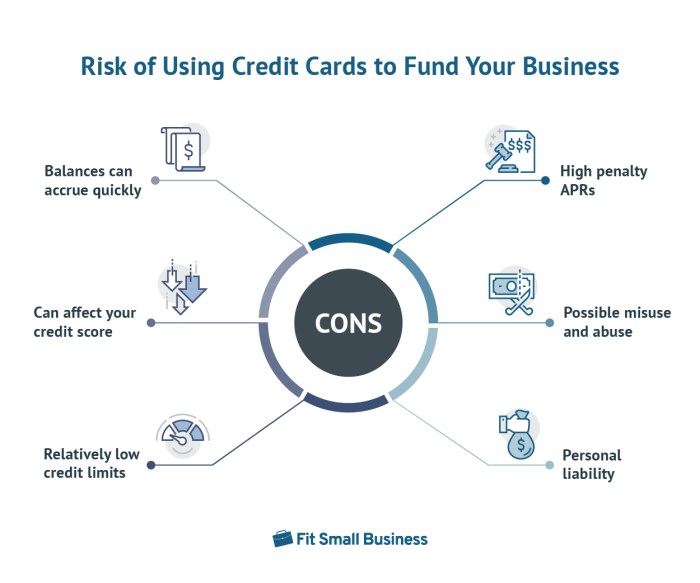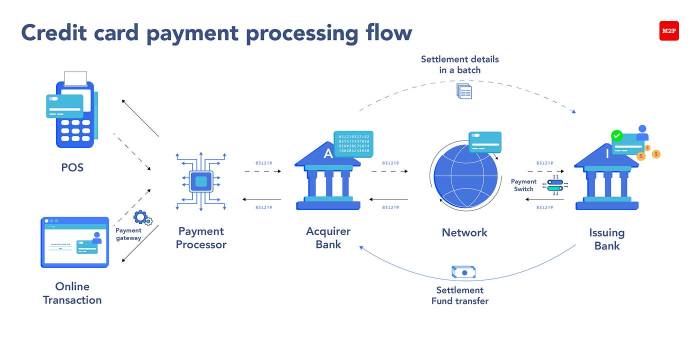How to Use Credit Cards for Small Business Funding Effectively
How to use credit cards for small business funding effectively is a crucial skill for entrepreneurs. Mastering this involves understanding various card options, responsible spending habits, and strategic repayment plans. This guide will navigate you through the process, from choosing the right card to integrating credit card usage into a broader financial strategy, ultimately empowering you to leverage credit cards for growth while mitigating potential risks.
We’ll explore the advantages and disadvantages of using credit cards for short-term funding, emphasizing the importance of maintaining a healthy credit score and avoiding excessive debt. We’ll also delve into practical strategies for minimizing interest payments and building a sustainable financial plan that incorporates credit cards as a valuable tool.
Understanding Credit Card Options for Small Businesses
Choosing the right business credit card can significantly impact your cash flow and financial health. Understanding the various options available, including their features and application processes, is crucial for making an informed decision that benefits your small business. This section will explore different business credit cards, comparing their rewards programs and interest rates, and outlining the application process.
Business Credit Card Comparisons: Rewards and Interest Rates, How to use credit cards for small business funding effectively
Business credit cards offer a range of rewards programs, from cash back to travel points, and interest rates vary considerably depending on factors like creditworthiness and the card’s terms. Generally, cards with higher rewards often come with higher interest rates. It’s vital to weigh the benefits of rewards against the potential cost of carrying a balance. Some cards may offer introductory 0% APR periods, which can be advantageous for managing short-term expenses.
However, remember that the APR will eventually revert to the standard rate, so careful budgeting is crucial. Furthermore, consider the types of expenses you incur most frequently; a card offering high rewards on those specific expenses will be more beneficial than a card with a broader, less targeted rewards program.
Business Credit Card Application Process and Required Documentation
Applying for a business credit card typically involves completing an online application, providing personal and business information, and submitting supporting documentation. The required documents vary depending on the lender and the applicant’s business structure. Commonly requested documents include a government-issued ID, business registration documents (such as an EIN or articles of incorporation), business bank statements, and personal credit reports.
Some lenders may also request tax returns or financial statements to assess the business’s financial health and creditworthiness. It’s important to have all necessary documentation readily available before beginning the application process to ensure a smoother and faster approval. Be prepared for a thorough review of your credit history and business financials.
Comparison of Business Credit Cards
The following table compares four hypothetical business credit cards to illustrate the range of options available. Remember that actual rates and rewards can change, so always check the latest information directly with the card issuer.
| Credit Card | Annual Fee | APR (Variable) | Rewards Structure |
|---|---|---|---|
| Card A | $0 | 18.24% | 1.5% cash back on all purchases |
| Card B | $95 | 16.99% | 2% cash back on office supplies, 1% on other purchases |
| Card C | $0 | 21.99% | 2x points on travel and dining, 1x point on other purchases |
| Card D | $150 | 19.49% | 1.5% cash back on all purchases, plus a $100 annual statement credit |
Responsible Credit Card Usage for Funding
Utilizing credit cards effectively for small business funding requires a disciplined approach. Ignoring responsible practices can quickly lead to overwhelming debt and damage your business’s financial health. This section Artikels key strategies for maintaining control and maximizing the benefits of credit card financing.Maintaining a good credit score is paramount for securing favorable credit card terms. A higher credit score translates to lower interest rates, higher credit limits, and better chances of approval for business credit cards.
This directly impacts your ability to access funding and manage your expenses efficiently. Lenders view a strong credit score as an indicator of responsible financial behavior, making you a less risky borrower. Conversely, a poor credit score can result in higher interest rates, lower credit limits, or even denial of credit applications, severely limiting your funding options.
Credit Score Maintenance for Favorable Terms
A strong credit history is built over time through consistent responsible financial behavior. This involves consistently paying bills on time, keeping credit utilization low (ideally under 30% of your available credit), and maintaining a diverse mix of credit accounts. Regularly checking your credit report for errors and addressing them promptly is also crucial. Consider using credit monitoring services to track your score and identify potential issues.
Building and maintaining a good credit score is an ongoing process, requiring consistent effort and attention. The rewards, however, are substantial, leading to better access to capital and reduced financing costs.
Budgeting and Expense Tracking to Manage Debt
Effective budgeting and expense tracking are essential to avoid accumulating excessive debt. Develop a detailed budget outlining all anticipated income and expenses. Categorize your expenses to identify areas where you can potentially reduce spending. Use accounting software or spreadsheets to meticulously track your credit card transactions, ensuring you stay within your budget. Regularly reconcile your credit card statements with your records to catch discrepancies early.
This detailed approach allows you to monitor your spending habits and proactively manage your debt levels, preventing them from spiraling out of control. For example, setting aside a specific amount each month to pay down your credit card balance, even if it’s a small amount, will make a difference over time.
Best Practices Checklist for Responsible Credit Card Usage
The following checklist summarizes key best practices for responsible credit card usage in a small business context:
- Pay your credit card bills on time, every time. Late payments severely impact your credit score.
- Keep your credit utilization low (ideally below 30%). High utilization negatively affects your credit score.
- Track all credit card transactions meticulously using accounting software or spreadsheets.
- Review your credit card statements regularly to identify and address any discrepancies.
- Create a realistic budget and stick to it. Plan for unexpected expenses.
- Explore different credit card options and choose the one that best suits your business needs and financial situation.
- Read the terms and conditions of your credit card agreement carefully.
- Avoid carrying a balance if possible; pay off your balance in full each month.
- Monitor your credit score regularly and address any issues promptly.
- Consider using a budgeting app or software to automate tracking and alerts.
Utilizing Credit Cards for Short-Term Funding
Credit cards can serve as a valuable tool for bridging short-term cash flow gaps for small businesses. Their accessibility and relatively quick approval process make them a convenient option when immediate funds are needed to cover unexpected expenses or seasonal fluctuations in revenue. However, it’s crucial to understand both the benefits and potential drawbacks before relying heavily on this form of financing.Credit cards offer a flexible and readily available source of short-term capital.
They can be used to cover immediate operational expenses, such as paying suppliers, covering payroll, or addressing unexpected repairs. This allows businesses to maintain operations and meet their financial obligations without disrupting their long-term financial plans. The ease of access contrasts sharply with the often lengthy application processes associated with traditional loans.
Examples of Beneficial Short-Term Credit Card Use
Using credit cards strategically for short-term funding can significantly benefit small businesses in various situations. For instance, a seasonal business might use a credit card to cover increased inventory costs during peak season, knowing that the increased sales will allow them to repay the balance quickly. Similarly, a small restaurant experiencing an unexpected equipment malfunction could utilize a credit card to cover the repair costs, preventing a disruption in service.
Another example is a small retailer needing to quickly replenish stock after a successful promotional campaign that unexpectedly depleted inventory. In each scenario, the short-term use of credit card financing allows the business to maintain momentum and avoid potentially costly disruptions.
Potential Pitfalls of Heavy Reliance on Credit Cards for Short-Term Funding
While credit cards provide a convenient solution for short-term funding, over-reliance can lead to significant financial difficulties. The high interest rates associated with credit cards can quickly accumulate substantial debt if balances aren’t paid down promptly. This can severely impact a business’s cash flow and profitability, potentially leading to long-term financial instability. Furthermore, accumulating high credit card debt can negatively impact a business’s credit score, making it more difficult to secure loans or other forms of financing in the future.
It’s essential to develop a repayment plan and to avoid using credit cards for expenses that can be covered through other means. Ignoring these risks can transform a useful short-term solution into a long-term financial burden.
Strategic Payment Strategies to Minimize Interest
Effectively managing credit card debt for your small business requires a proactive approach to repayment. Minimizing interest charges is crucial for maintaining healthy finances and maximizing the benefits of using credit cards for business funding. Strategic payment strategies can significantly reduce the overall cost of borrowing and improve your business’s financial health.Understanding how different payment methods impact your total cost is key.
This involves calculating not only the minimum payments but also the total interest accrued over the repayment period. By adopting a structured approach to repayment, you can save substantially on interest and improve your creditworthiness.
Debt Repayment Methods: Snowball vs. Avalanche
Choosing the right repayment strategy depends on your personal preference and financial situation. Two popular methods are the snowball and avalanche methods. The snowball method focuses on paying off the smallest debt first, regardless of interest rate, to build momentum and motivation. The avalanche method prioritizes paying off the debt with the highest interest rate first, to minimize overall interest paid.The snowball method provides a psychological boost by quickly eliminating debts, encouraging continued repayment efforts.
However, it might cost more in the long run due to higher interest charges on larger debts. The avalanche method, while potentially slower to initially see results, saves money on interest in the long run. Choosing between these methods involves weighing the psychological benefits of the snowball against the financial benefits of the avalanche.
Calculating the Total Cost of Credit Card Financing
Calculating the total cost involves understanding the Annual Percentage Rate (APR), the interest rate charged on your outstanding balance. The APR is usually stated clearly on your credit card statement. To determine the total cost, you need to consider the principal amount borrowed, the APR, and the repayment period. Many online calculators are available to simplify this process, but the fundamental calculation involves compounding interest over time.
Total Cost = Principal + (Principal x APR x Time)
This formula provides a basic estimate. The actual cost may vary slightly depending on the specific credit card terms and the chosen repayment schedule. Accurate calculation requires factoring in any additional fees, such as late payment fees or balance transfer fees. It is crucial to consult your credit card agreement for the precise terms and conditions.
Financial Implications of Carrying a Balance vs. Paying in Full
Carrying a balance versus paying in full each month significantly impacts your financial health. Paying in full each month avoids any interest charges. However, carrying a balance, even a small one, leads to accumulating interest charges that compound over time. This can quickly escalate the total cost of using the credit card, reducing the benefits of the credit line.For example, let’s assume a $1,000 balance on a credit card with a 18% APR.
If paid in full each month, the total cost is simply $1,000. If only the minimum payment is made, let’s say $25, the interest will accrue on the remaining balance. Over time, the total cost will be significantly higher than $1,000, potentially doubling or even tripling the initial amount due to accumulating interest. This illustrates the importance of making at least the minimum payment consistently, and ideally, paying the balance in full whenever possible.
Illustrative Examples of Successful Credit Card Use: How To Use Credit Cards For Small Business Funding Effectively
Successfully leveraging credit cards for small business funding requires careful planning and execution. Understanding the risks and rewards, and implementing a robust strategy, is crucial for positive financial outcomes. The following case studies illustrate how different businesses have effectively used credit cards to fuel growth, highlighting both their successes and the lessons learned.
Case Study 1: The Expanding Bakery
This local bakery, “Sweet Success,” initially struggled with limited capital to expand its production capacity. They strategically used a business credit card with a low introductory APR to purchase a new commercial oven and additional display cases. Their strategy involved meticulously tracking expenses, paying off a significant portion of the balance each month, and utilizing rewards points to offset some operating costs.
This approach allowed them to increase production, leading to a 30% increase in revenue within the first year. The key takeaway for Sweet Success was the importance of disciplined spending and prompt repayment to minimize interest charges.
Case Study 2: The Growing Online Retailer
“Tech Trends,” an online retailer specializing in tech accessories, used a credit card with a high credit limit and rewards program to manage its inventory. They leveraged the extended payment terms to purchase bulk orders of popular products, taking advantage of wholesale discounts. The rewards points earned were used to cover advertising expenses on social media platforms, boosting brand visibility and sales.
Their careful management of cash flow, coupled with a clear understanding of their sales cycles, allowed them to consistently pay down their credit card balance, preventing the accumulation of substantial interest. Their success underscores the value of choosing a card aligned with their business needs and effectively leveraging rewards programs.
Case Study 3: The Expanding Consulting Firm
“Strategic Solutions,” a consulting firm, used a business credit card to cover short-term expenses related to client projects, such as travel and software subscriptions. They opted for a card with a low annual fee and a competitive interest rate. Their strategy involved budgeting carefully for each project and allocating funds to repay the credit card balance promptly upon project completion.
This allowed them to maintain a positive cash flow while still having access to funds for immediate operational needs. Their experience emphasizes the importance of selecting a credit card with features suitable for their cash flow cycle and consistently monitoring their spending habits.
| Business | Credit Card Strategy | Financial Outcomes | Lessons Learned |
|---|---|---|---|
| Sweet Success (Bakery) | Low introductory APR card, focused on prompt repayment, utilized rewards points. | 30% revenue increase in first year. | Disciplined spending and prompt repayment are crucial. |
| Tech Trends (Online Retailer) | High credit limit card, leveraged rewards for advertising, managed cash flow effectively. | Increased sales through enhanced marketing and inventory management. | Align card choice with business needs and leverage rewards programs. |
| Strategic Solutions (Consulting Firm) | Low annual fee card, project-based repayment, careful budgeting. | Maintained positive cash flow while accessing funds for immediate needs. | Choose a card suitable for cash flow cycle and monitor spending habits. |
Successfully using credit cards for small business funding hinges on a combination of careful planning, disciplined spending, and strategic repayment. By understanding the various card options, implementing responsible usage practices, and integrating credit cards into a comprehensive financial strategy, small business owners can effectively leverage this financial tool for growth and stability. Remember, while credit cards offer valuable short-term solutions, long-term financial health depends on responsible management and a clear understanding of the associated risks and rewards.
Commonly Asked Questions
What is the best business credit card for my business?
The “best” card depends on your specific needs and spending habits. Consider factors like annual fees, APR, rewards programs, and credit limits when making your decision. Comparing offers from several providers is recommended.
Can I use a personal credit card for business expenses?
While possible, it’s generally not recommended. Mixing personal and business finances can complicate accounting, tax preparation, and liability issues. A dedicated business credit card offers better organization and protection.
What happens if I can’t pay my business credit card balance in full?
Carrying a balance will incur interest charges, significantly increasing the overall cost. Explore options like balance transfers or debt consolidation to manage high balances and reduce interest payments. Contact your credit card issuer to discuss repayment options if you anticipate difficulty.


